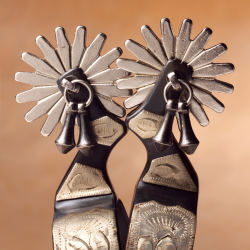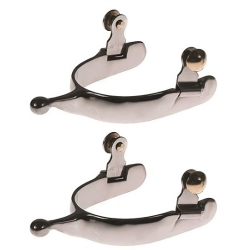Welcome to our blog post on understanding and using a roping breast collar for horses. If you're a horse owner or rider, you may already be familiar with the importance of proper equipment when it comes to the comfort and safety of your equine partner. A roping breast collar is a crucial piece of gear that not only enhances your horse's performance but also provides added security during challenging activities like roping and ranch work.
In this blog post, we will delve into the world of roping breast collars, exploring why they are used, the benefits they offer, and how to choose the right one for your horse. We will also discuss proper use and maintenance, common issues that may arise, and how to address them effectively.
Understanding the role of a roping breast collar and its significance in horse riding is essential. By properly equipping your horse with this specialized gear, you can ensure their comfort, prevent injuries, and maximize their potential in various equestrian disciplines.
So, whether you're a seasoned roper, a rancher, or simply interested in learning more about horse equipment, this blog post will provide you with valuable insights and practical tips on using a roping breast collar effectively. Let's dive in and discover how this essential piece of equipment can benefit both you and your horse.
Introduction to Roping Breast Collars
A roping breast collar is a specialized piece of horse equipment that plays a vital role in the world of roping and ranch work. It is designed to secure the saddle in place, preventing it from sliding backward during abrupt stops or when roping cattle. This section will provide you with an introduction to roping breast collars, their purpose, and how they differ from other types of breast collars.
What is a Roping Breast Collar?
A roping breast collar is a strap or harness-like piece of equipment that is placed across the chest of a horse, just behind the shoulders. It consists of a wide, padded strap that extends horizontally from one side of the horse's chest to the other, passing between the front legs and attaching to the saddle or cinch. The collar is usually made of leather, nylon, or a combination of both materials.
Purpose of a Roping Breast Collar
The primary purpose of a roping breast collar is to prevent the saddle from sliding backward on the horse's back. When a rider engages in roping activities, sudden stops and changes in direction can put significant pressure on the horse's withers (the highest part of the shoulder blades). Without a breast collar, the saddle may shift backward, causing discomfort to the horse and compromising the rider's balance and control.
How is a Roping Breast Collar Different?
While there are various types of breast collars available for horses, the roping breast collar is specifically designed for the demands of roping and ranch work. It differs from other breast collars in a few key ways:
-
Size and Width: Roping breast collars are typically wider and more substantial compared to other types. The increased width helps distribute the pressure more evenly across the horse's chest, reducing the risk of discomfort or rubbing.
-
Attachment Points: Roping breast collars typically have two attachment points - one on each side of the horse's chest. These attachment points connect to the saddle or cinch, providing stability and preventing the saddle from shifting backward.
-
Reinforced Design: Roping breast collars are often reinforced with additional layers of padding or sturdy materials. This reinforcement helps withstand the rigors of roping activities and ensures durability over time.
Now that we have covered the basics of roping breast collars, let's explore the reasons why using a roping breast collar can be beneficial for both horse and rider.
Why Use a Roping Breast Collar?
Using a roping breast collar offers several benefits for both the horse and the rider. In this section, we will explore the advantages of utilizing a roping breast collar during various equestrian activities.
Benefits of Using a Roping Breast Collar
-
Enhanced Stability and Security: One of the primary benefits of using a roping breast collar is the added stability it provides to the saddle. During quick stops or when roping cattle, the collar helps prevent the saddle from sliding backward, ensuring a secure and balanced position for the rider. This increased stability allows the rider to maintain control and execute maneuvers with precision.
-
Increased Comfort for the Horse: A properly fitted and padded roping breast collar can significantly enhance the horse's comfort. By preventing the saddle from shifting backward, the collar eliminates the potential discomfort and pressure points that may arise from an ill-fitting or unstable saddle. This added comfort translates to a happier and more willing equine partner.
-
Improved Performance: With a roping breast collar in place, the horse can move more freely and efficiently. The secure saddle position allows the horse to engage its hindquarters effectively, enabling powerful stops, quick turns, and smooth transitions. The enhanced performance potential can be particularly advantageous in roping events, ranch work, and other disciplines that require agility and control.
-
Injury Prevention: A roping breast collar plays a crucial role in preventing injuries to both the horse and the rider. By keeping the saddle in place, it reduces the risk of the saddle slipping sideways or backward, which could lead to accidents or falls. Additionally, the collar helps distribute pressure evenly across the horse's chest, minimizing the likelihood of discomfort, rubbing, or chafing.
-
Versatility: While roping breast collars are primarily used in roping and ranch work, they can also be beneficial in other equestrian disciplines. They provide an added layer of security and stability for activities such as trail riding, barrel racing, or even jumping. Their versatility makes them a valuable addition to any rider's equipment collection.
Understanding the various benefits of using a roping breast collar emphasizes its importance in ensuring the safety, comfort, and performance of both horse and rider. In the next section, we will delve deeper into the specific role of a roping breast collar in horse riding activities.
Choosing the Right Roping Breast Collar
Choosing the right roping breast collar is essential to ensure optimal performance, comfort, and safety for both you and your horse. In this section, we will discuss important factors to consider when selecting a roping breast collar.
Material and Quality
-
Leather: Leather is a popular choice for roping breast collars due to its durability, strength, and classic appearance. Look for high-quality, thick leather that can withstand the rigors of roping activities. Ensure that the leather is well-oiled and properly conditioned to maintain its flexibility and longevity.
-
Nylon: Nylon roping breast collars are lightweight, easy to clean, and less expensive compared to leather. They are also resistant to water damage and do not require as much maintenance. However, make sure to choose a nylon collar with sturdy hardware and reinforced stitching to ensure durability.
-
Combination: Some roping breast collars combine leather and nylon, offering the benefits of both materials. These collars often feature a leather base with nylon reinforcements, providing strength and flexibility.
Regardless of the material you choose, prioritize quality craftsmanship and attention to detail. Look for sturdy hardware, reinforced stitching, and well-finished edges to ensure a reliable and long-lasting roping breast collar.
Fit and Comfort
-
Size and Adjustability: Proper fit is crucial for a roping breast collar. It should fit snugly around the horse's chest, allowing enough room for movement but not too loose to compromise stability. Look for collars with adjustable straps or buckles to ensure a customized fit for your horse.
-
Padding: Opt for a roping breast collar with adequate padding to maximize comfort and reduce the risk of rubbing or chafing. Soft padding helps distribute pressure evenly across the chest, enhancing the horse's comfort during intense activities.
-
Shoulder Freedom: Ensure that the roping breast collar does not restrict the horse's shoulder movement. It should sit just behind the shoulders, allowing the horse to move freely without hindrance.
Aesthetics and Design
While aesthetics may not directly impact the functionality of the roping breast collar, it is still worth considering your personal preferences and style. Roping breast collars come in various designs, colors, and patterns. Choose one that reflects your taste and complements your other horse gear.
By considering the material and quality, fit and comfort, as well as aesthetics and design, you can select a roping breast collar that meets your specific needs and preferences. In the next section, we will discuss how to properly use and maintain a roping breast collar to ensure optimal performance and longevity.
Proper Use and Maintenance of a Roping Breast Collar
Proper use and maintenance of a roping breast collar are crucial for ensuring its effectiveness, longevity, and the safety of both horse and rider. In this section, we will discuss how to properly use and maintain a roping breast collar.
How to Properly Fit a Roping Breast Collar
-
Adjust the Straps: Start by adjusting the straps or buckles on the roping breast collar to ensure a snug fit. The collar should rest just behind the horse's shoulders, with enough room for movement but not too loose that it compromises stability.
-
Check for Clearance: Make sure there is enough clearance between the horse's skin and the collar to prevent rubbing or chafing. It should be snug against the chest but not overly tight.
-
Secure the Attachment Points: Attach the roping breast collar to the saddle or cinch using the provided attachment points. Ensure that the attachment points are securely fastened to prevent any slippage or movement.
-
Observe the Horse's Comfort: Pay attention to your horse's comfort while wearing the roping breast collar. Watch for signs of discomfort, such as rubbing, sweating, or resistance. Adjust the fit if necessary.
Regular Cleaning and Care
-
Remove Debris: After each use, remove any dirt, dust, or debris from the roping breast collar. Use a soft brush or cloth to gently wipe away any residue.
-
Clean with Mild Soap: Periodically, clean the roping breast collar using a mild soap solution and warm water. Avoid using harsh detergents or chemicals that may damage the material. Rinse thoroughly and allow it to dry completely before use.
-
Condition the Leather: If your roping breast collar is made of leather, regularly apply a leather conditioner to keep the material supple and prevent cracking or drying out. Follow the manufacturer's instructions for the appropriate conditioning products.
Checking for Wear and Tear
-
Inspect Regularly: Routinely inspect the roping breast collar for any signs of wear, such as frayed stitching, loose hardware, or damaged padding. Address any issues promptly to maintain the collar's integrity.
-
Replace Worn Parts: If you notice any significant wear or damage, replace the affected parts or consider investing in a new roping breast collar. Do not compromise safety by using equipment that is in poor condition.
-
Store Properly: When not in use, store the roping breast collar in a clean and dry area, away from direct sunlight or extreme temperatures. Proper storage helps prevent deterioration and prolongs its lifespan.
By following these guidelines for proper use and maintenance, you can ensure that your roping breast collar remains in excellent condition, providing optimal performance and comfort for your horse. In the next section, we will address common issues that may arise with roping breast collars and provide solutions to overcome them.
Common Issues and Solutions with Roping Breast Collars
Despite their importance and benefits, roping breast collars may encounter certain issues that can affect their functionality and effectiveness. In this section, we will explore some common issues that horse owners may face with roping breast collars and provide practical solutions to overcome them.
Issues with Fit
-
Collar Slipping Forward: If the roping breast collar tends to slip forward towards the horse's neck, it may indicate an improper fit. Adjust the straps or buckles to ensure a snug fit behind the shoulders, allowing enough room for movement but preventing excessive forward movement.
-
Collar Slipping Backward: On the other hand, if the roping breast collar slips backward towards the horse's belly, it may indicate that it is too loose. Tighten the straps or buckles to achieve a more secure fit and prevent backward movement.
Issues with Comfort for the Horse
-
Rubbing or Chafing: If the horse experiences rubbing or chafing from the roping breast collar, check for any rough edges, loose stitching, or improper padding. Smooth out any rough areas, reinforce stitching if needed, and ensure that the collar is properly padded to minimize discomfort.
-
Shoulder Restriction: If the horse's shoulder movement seems restricted or hindered by the roping breast collar, reassess the fit and position of the collar. Ensure that it rests just behind the shoulders, allowing freedom of movement without causing any discomfort or restriction.
Issues with Durability
-
Frayed or Loose Stitching: Over time, the stitching on a roping breast collar may become frayed or loose, compromising its strength and integrity. Regularly inspect the collar for any signs of wear and address frayed or loose stitching promptly by repairing or replacing the affected areas.
-
Damaged Padding: If the padding on the roping breast collar becomes worn out or damaged, it may lose its effectiveness in providing comfort and protection. Replace any damaged padding to ensure the horse's comfort and prevent potential rubbing or chafing.
It is essential to address any issues promptly to maintain the functionality and safety of the roping breast collar. Regular inspection, proper fitting, and timely repairs or replacements will help keep the collar in optimal condition.
In the next section, we will conclude our discussion by emphasizing the importance of maximizing the benefits of a roping breast collar and summarizing the key takeaways from this blog post.
Conclusion: Maximizing the Benefits of a Roping Breast Collar
In conclusion, understanding and effectively using a roping breast collar can greatly enhance your horse riding experience, particularly in activities such as roping and ranch work. By securing the saddle in place, a roping breast collar provides stability, comfort, and safety for both horse and rider.
Throughout this blog post, we have explored the various aspects of roping breast collars, including their purpose and benefits, factors to consider when choosing one, proper use and maintenance techniques, as well as common issues and solutions. Here are the key takeaways:
-
Roping breast collars are specifically designed to prevent the saddle from sliding backward during abrupt stops or roping activities, providing stability and balance for the rider.
-
When choosing a roping breast collar, consider the material and quality, ensuring durability and strength. Pay attention to fit and comfort for the horse, and select a design that suits your personal preferences.
-
Properly fitting a roping breast collar involves adjusting the straps, ensuring clearance, and observing the horse's comfort during use.
-
Regular cleaning, conditioning (for leather collars), and inspection for wear and tear are essential for maintaining the roping breast collar's integrity.
-
Common issues with roping breast collars include fit problems, discomfort for the horse, and durability concerns. Promptly address these issues by adjusting the fit, resolving rubbing or chafing, and repairing or replacing damaged parts.
By maximizing the benefits of a roping breast collar, you can enhance your horse's comfort, performance, and safety. Remember to choose a high-quality collar, properly fit and maintain it, and address any issues that may arise. With a well-fitted and maintained roping breast collar, you can enjoy your equestrian activities with confidence and ensure the well-being of your equine partner.
We hope that this comprehensive guide has provided you with valuable insights and practical tips for understanding and using a roping breast collar for horses. Happy riding!












































